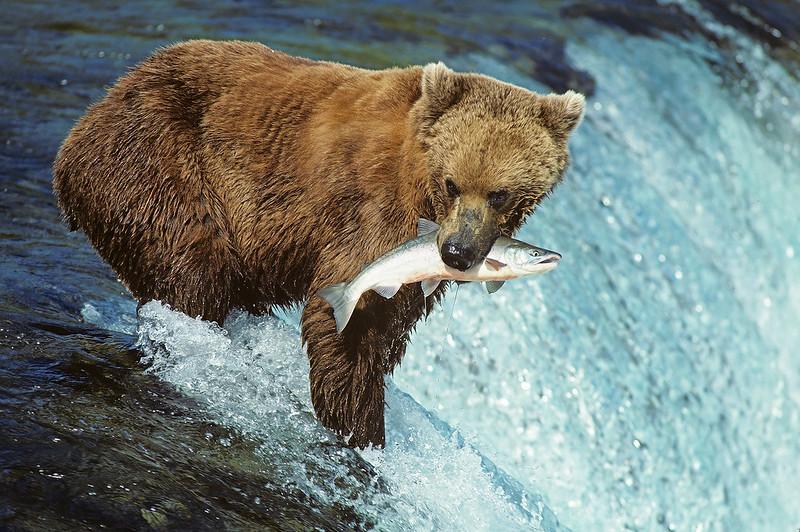Ocean acidification occurs when the pH level of seawater decreases, which is most frequently caused by the ocean absorbing excess CO2 from the atmosphere. Ocean acidification has negative effects on a variety of ocean ecosystems and life forms, including salmon.
This article will explain how salmon are affected by ocean acidification, as well as the importance of salmon to ecosystems, people, and the economy
Background information: Ocean Acidification Infographic
Table of Contents
How Are Salmon Affected by Ocean Acidification?
How Are Salmon Affected by Ocean Acidification?

Salmon and other fish species feel the impact of ocean acidification. As acidity levels rise in the ocean, chemical imbalances are created within their bodies, which are normally balanced with the pH of the surrounding water. This can affect salmon’s behavior and abilities. Here are some of the ways ocean acidification negatively affects salmon.
Ocean Acidification Affects Salmon’s Ability to Sense Danger
Salmon are known for their extreme sense of smell, which is essential for them to search for food and avoid predators. However, when ocean acidification rises, salmon’s ability to smell is altered. According to a 2018 study, salmon that have been exposed to acidified seawater stop showing a response to the scent that tells them there’s danger nearby.
In the study, researchers created three separate salmon tanks, each with a different level of seawater acidity. After two weeks of exposure to the water, salmon in the tank with the lowest acidity levels exhibited normal reactions when the “danger scent” was put into the water. In fact, most of the time, the low-acidity salmon entirely avoided the section of the tank where the scent was coming from. On the other hand, salmon in the tank with the highest acidity levels did not respond to the “danger scent” at all, and made no attempts to avoid it.
The study reveals that ocean acidification can negatively affect salmon’s ability to sense danger. This may result in an increased mortality rate and population decrease in salmon exposed to ocean acidification.
Watch how acidic water affects salmon’s sense of smell in this demonstration from the University of Washington:
Ocean Acidification Affects Salmon’s Ability to Navigate Home
Salmon are anadromous, which means that as they mature, they migrate from the ocean to their natural spawning grounds in rivers to lay eggs. They use their extreme sense of smell to navigate the seas and rivers. This phenomenon is essential for salmon to reproduce and thrive. Unfortunately, the effects of ocean acidification on their sense of smell alter their ability to navigate home. This could prevent them from reproducing and spawning, which could also contribute to declines in their population.
Ocean Acidification Reduces Salmon’s Food Sources
In the wild, salmon mainly feed on crabs, krill, and shrimps. the negative effects of ocean acidification may impact the populations of shell-forming organisms, including many species that salmon commonly rely on for food. This could lessen the availability of salmon’s food sources, which could lead to starvation, or changing their diet. This might result in a decline in the essential nutrients salmon get from their original diet to sustain their characteristic pink features and health. In the long run, this may raise their mortality rate, reducing their population.
The Importance of Salmon
Salmon play an important role in maintaining healthy ocean and river ecosystems. They also provide benefits for marine wildlife, terrestrial wildlife, and people. However, the increasing threat of ocean acidification puts the important services that salmon provide at risk. Here are some of the ways salmon are important to ecosystems, wildlife, and people.
The Importance of Salmon to Ecosystems and Wildlife
Natural Nutrient Transporter
Since salmon are anadromous, they contribute to the transportation of nutrients from the ocean to rivers and streams. For example, in Alaska, approximately 170 tons of phosphorus are transported from the oceans to Lake Illiamna annually due to the migration of sockeye salmon. Aside from phosphorus, salmon also provide nitrogen to rivers, streams, and lakes. After they lay eggs, salmon die and release nitrogen into the waters. Phosphorus and nitrogen are essential to the growth of microorganisms and vegetation, and provide necessary nutrients to wildlife that inhabit the lake.
Food Source for Wildlife
Salmon serves as food for various types of marine and terrestrial animals. Here are some of the species that rely on salmon as their source of food:
- Brown bears rely on a salmon diet for the rich calories it provides. Salmon are essential for bears, as bears need to consume around 5,000 to 20,000 calories per day, depending on the season.
- Sharks, seals, and orcas consume salmon in the ocean. Salmon provides nutrients that are essential for their growth.
- Bald eagles and other predatory birds that live on riversides feed on salmon when the fish return to their spawning grounds in shallow rivers and streams.

Source: Gary Lackie/Flickr
The consequences of ocean acidification may have an impact on the availability of salmon in areas where animals and plants rely on them for nutrients and food. If the ocean continues to acidify, it will not only harm salmon, but will also have a detrimental domino effect on the ecosystem and other species that rely on the fish.
The Importance of Salmon to People and the Economy
How Salmon Benefit the Aquaculture Industry
Industrialized salmon farming started in the 1980s in Norway and quickly grew into a global industry. Today, salmon aquaculture is one of the fastest growing methods of food production today, and makes up about 70% of the global market. Salmon have a huge impact on the global economy, so the effects of ocean acidification on salmon could be quite disruptive.
How Salmon Benefit People’s Livelihoods
In 2018, almost 60 million people relied on the aquaculture industry for their source of income. Because salmon is the most-produced fish in the global aquaculture industry, it provides millions of people with employment and income.
Health Benefits of Eating Salmon

In the 1980s, salmon was considered a fancy dish in some countries, but as the industry grew salmon became more widely available, and the health benefits and nutrients it provides to humans spread to practically every corner of the globe. Here are some examples of the health benefits of salmon:
- Salmon is a good source of protein, which is essential to building muscle mass and growth.
- Salmon is rich in vitamin b12 and iron, which are essential to the formation of red blood cells. This can prevent blood-related conditions like anemia.
- Salmon contains potassium, which is essential in maintaining healthy muscle condition and nerve function.
- Salmon also contains vitamin D, which boosts immune systems.
- Salmon contains high omega 3 fatty acids. This is great for maintaining a healthy heart and reducing the chance of getting several diseases such as heart attacks, cancer, dementia, and Alzheimer’s.
The issues salmon face from ocean acidification are exacerbated by the negative pressures humans have placed on salmon populations. This includes urbanization, pollution, and dam constructions. If worsening ocean acidification is added to these pressures, salmon may not be able to continue to adapt to declining environmental conditions, and their populations will suffer.
Salmon provide a variety of services and health benefits to people, the economy, wildlife, and ecosystems, but they are threatened by ocean acidification. Ocean acidification jeopardizes the benefits we get from salmon and it may also create an ecological imbalance that could lead to other species’ extinction.